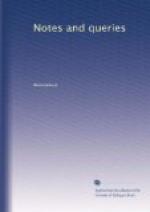Bishop Hurd, in a note on the Epistle to Augustus, p. 72., says:
“Malherbe was to the French pretty much what Horace had been to Latin poetry. These great writers had, each of them, rescued the lyric muse of their country out of the rude ungracious hands of their old poets. And, as their talents of a good ear, elegant judgment, and correct expression, were the same, they presented her to the public in all the air and grace, and yet severity, of beauty, of which her form was susceptible.”
S.W. SINGER.
Mickleham, July 2. 1850.
* * * * *
“DIES IRAE, DIES ILLA.”
In reply to the first of Mr. SIMPSON’s Queries (Vol. ii., p. 72.) relative to the magnificent sequence Dies irae, I beg to say that the author of it is utterly unknown. The following references may be sufficient:—Card. Bona, Rer. Liturgic. lib. ii. cap. vi. p. 336., Romae, 1671; or, if possible, Sala’s edition, tom. iii. p 143., Aug. Turin. 1753; Gavantus, tom. i. pp. 274-5., Lugd. 1664; and the Additions by Merati, i. 117-18., Aug. Vindel, 1740; Zaccaria, Biblioth. Ritual. tom. i. p. 34., Romae, 1776; Oldoini Addit. ad Ciaconii Vit. Pontiff. et Cardd., tom. ii. col. 222., Romae, 1677.
Mr. SIMPSON’s second question is, “In what book was it first printed?” Joannes de Palentia, in his notes upon the Ordinarium PP. Praed., asserts that this celebrated prose was first introduced into the Venice editions of the Missals printed for the Dominicans. The oldest Missale Praedicatorum which I possess, or have an opportunity of seeing, is a copy of the Parisian impression of the year 1519; and herein the Dies irae is inserted in the Commemoratio Defunctorum; mens. Novemb. sig. M. 5.
An inquiry remains as to the date of the general adoption of this sequence by the Roman Church. In Quetif and Echard (Scriptt. Ord. Praed. i. 437.), under the name of Latinus Malabranca, we read that it certainly was not in use in the year 1255; and there does not appear to be the slightest evidence of its admission, even upon private authority, into the office for the dead anterior to the commencement of the fifteenth century.
Your correspondent was not mistaken in his belief that he had met with an imperfect transcript of this prose, for the original consists not of “twenty-seven,” but of fifty-seven lines. I may add that I do not remember to have found the text more correctly given than in the beautiful folio missal of the church of Augsburg, partly printed on vellum in 1555 (fol. 466. b.).
R.G.
The Dies Irae is truly said by Mr. SPARROW SIMPSON (Vol. ii., p. 72.) to be an extremely beautiful hymn. Who was its author is very doubtful, but the probabilities are in favour of Thomas de Celano, a Minorite friar, who lived during the second half of the fourteenth century. It consists of nineteen strophes, each having three lines. Bartholomew of Pisa, A.D. 1401, in his Liber Conformitatum, speaks of it; but the earliest printed book in which I have ever seen this hymn, is the Missale Romanum, printed at Pavia, A.D. 1491, in 8vo., a copy of which I have in my possession.




